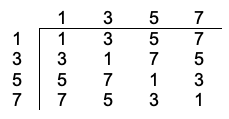A group is a set, together with a chosen binary operation, that satisfies the properties of closure, identity, inverse and associativity as follows:
-
- Closure: if
and
are elements of the group
, then
is also an element of
.
- Identity: there exists an element called the identity, which is denoted by
, such that
for
.
- Inverse: every element
in
has an inverse
, which is itself an element of
, such that
.
- Associativity:
for all
.
- Closure: if
Consider the set under the binary operation of addition mod 4. It is a group because it satisfies the four properties mentioned above. For example, the element 0 is the identity, since
, where
. As for inverses,
, because
gives the identity. Similarly,
,
and
. The closure and associativity properties can be easily verified.

Question
What is addition mod 4 for the set ?
Answer
It means that if the sum of two elements of the set is greater than 3, then we divide the result by 4 (called the modulus) and take the remainder as the answer. For example, ,
and
.
Similarly, the set under the binary operation of multiplication mod 8 is a group. In this case, if the product of two elements of
is greater than 7, we divide the result by 8 and take the remainder as the answer. All possible binary operations and answers can be presented in the form of a multiplication table as follows:

where the left operand and right operand of the binary operation are listed in the top row and the leftmost column respectively.
Clearly, the multiplication of integers is associative. From the multiplication table, we can validate the closure property of , authenticate that 1 is the identity element and determine that the inverse of an element is the element itself. The associativity property is also easily verified separately.

Question
Is the set under the binary operation of multiplication a group?
Answer
Yes, it is a trivial group with only one element.
If the results of all binary operations of a group are independent of the order of the operands (i.e., ), the group is said to be Abelian. Both groups
and
mentioned above are examples of Abelian groups.
The order of a group , denoted by
, is the number of elements in
. For example,
for both
and
. The order of an element
of a group
under the binary operation of multiplication, denoted by
, is the smallest value of
such that
. For example, the order of the all elements in the group
is 2.
Finally, some useful properties of a group can be inferred from the main properties of closure, identity, inverses and associativity. Two such inferred properties are:
- Cancellation
(Statement) If , then
for all
in the group
. In other words,
is “cancellable”.

According to the inverses property of a group, if , there exists a unique
, where
. The proof for the cancellation theorem then involves left-multiplying
by
and using the associativity and identity properties:

Question
Proof the uniqueness of inverses in a group, i.e. for each , there is a unique element
such that
.
Answer
Suppose has two inverses
and
. Then
or
. By cancellation,
.
- Rearrangement theorem
(Statement) Let and
. Suppose we multiply each element of
by
to form a new group
, where
. Then,
contains each element of
once and only once. In other words,
.
This theorem is proven by contradiction. Suppose two elements of are equal, where
. By cancellation, we have
, which contradicts the definition that a group is a set, which is a collection of different elements. However, if
, the order of elements in
may not be the same as that in
, and thus the term ‘rearrangement’.
